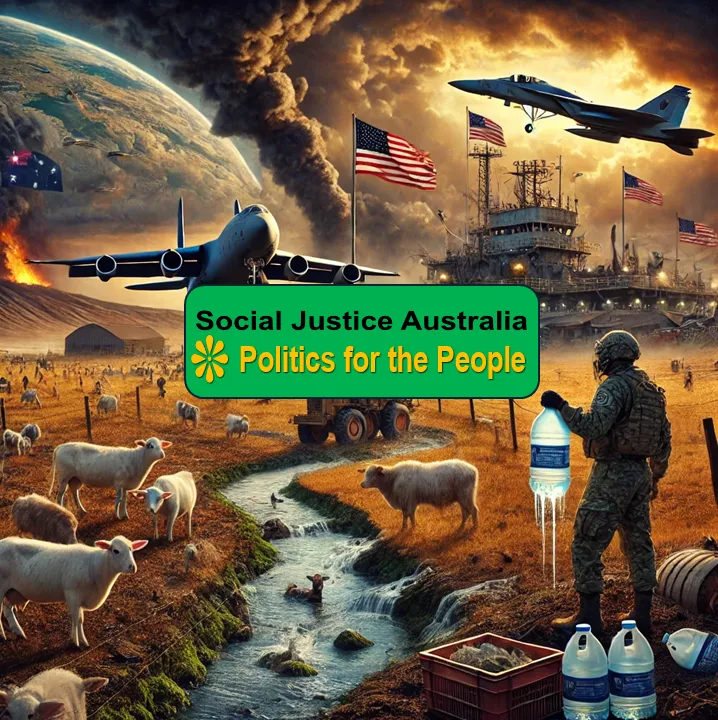Description
US military bases in Australia endanger our environment and security. Discover the damage they cause and how Australians can push for their removal.
Introduction
Picture this: A farmer in Williamtown, NSW, watches helplessly as his once-fertile land becomes toxic. His water source is contaminated, his livestock is sick, and his family’s health is deteriorating. The culprit? The nearby U.S. military base is leaking toxic PFAS chemicals into the environment.
Australians have long been told that hosting U.S. military bases makes the country safer, but at what cost? The presence of these bases has led to severe environmental degradation and heightened national security risks. This article explores the damage caused by U.S. military installations in Australia and how citizens can push for their removal.
The Environmental Destruction Caused by U.S. Military Bases in Australia
PFAS Contamination – Poisoning Our Water and Soil
Families in towns like Williamtown and Oakey are forced to buy bottled water because their groundwater is contaminated with per and poly-fluoroalkyl substances (PFAS). These toxic chemicals, used in firefighting foams on U.S. military bases, have been linked to cancer, liver damage, and immune system disorders.
Environmental reports indicate that PFAS contamination from military bases has made land unusable and driven down property values. This is not an isolated issue—similar contamination has been reported in the U.S. and other host countries.
Real-World Example: Residents of Oakey filed a class-action lawsuit seeking compensation for the damage caused by PFAS contamination, highlighting the devastating impact on their health and livelihoods.
Land Degradation and Destruction of Ecosystems
Military exercises have wreaked havoc on Australian ecosystems. Take Puckapunyal, where years of heavy military training have led to severe soil erosion, deforestation, and destruction of native habitats. The Australian Defence Force (ADF) has had to implement large-scale rehabilitation projects to restore these lands, but the damage is still significant.
Additionally, invasive species such as fire ants have spread due to poor biosecurity measures on military bases, further threatening Australia’s fragile biodiversity.
Historical Context: During World War II, military use of Australian land led to long-term damage, including unexploded ordnance in training zones, which is still an issue today.
Greenhouse Gas Emissions – A Major Polluter
The ADF is one of Australia’s largest carbon emitters, generating over 1.7 million tonnes of CO₂ annually. The U.S. military is even worse—if it were a country, it would rank as the world’s 47th largest carbon emitter. Hosting U.S. military operations means Australia bears part of that environmental burden, contradicting national climate goals.
Expert Opinion: Environmental scientists have called for stricter regulations on military emissions, arguing that they undermine Australia’s commitment to reducing its carbon footprint.
The National Security Threat of Hosting U.S. Military Bases
U.S. Military Presence Makes Australia a Target

Imagine a future conflict between the U.S. and China. Australia automatically becomes a military target with Darwin, Pine Gap, and Tindal bases. A Chinese missile strike on these bases would devastate Australian communities, dragging us into wars we did not choose.
Experts warn that hosting U.S. bases places Australia in a dangerous position, increasing the likelihood of conflict instead of deterring it.
Military Analysis: Former Australian Defence officials have voiced concerns that U.S. bases undermine our national security by making Australia an extension of American military strategy.
Loss of Sovereignty – Who Controls Our Defence Policy?
Successive Australian governments have signed defence agreements with the U.S. without public consultation. AUKUS, the latest military deal, commits Australia to long-term U.S. military priorities, undermining our independence.
When Australia allows U.S. forces to operate freely on its soil, it loses control over its military decisions. This compromises Australian sovereignty and prioritises American interests over national security.
Political Insight: Documents leaked in 2023 revealed that U.S. military officials exert considerable influence over Australian defence planning, reinforcing concerns about eroded sovereignty.
How Australian Citizens Can Demand the Removal of U.S. Military Bases
Raising Public Awareness
The first step is education. Many Australians are unaware of U.S. bases’ environmental and security risks. Sharing this information through independent media, social movements, and community discussions can build momentum for change.
Pressuring Politicians to Take a Stand
• Demand transparency in defence agreements.
• Call for national referendums on foreign military bases.
• Support politicians who prioritise Australian sovereignty over U.S. interests.
Protesting and Direct Action
• Organise mass demonstrations against U.S. military expansion.
• Boycott defence contractors profiting from war.
• Push for divestment from institutions supporting militarism.
Historical Success: The Philippines removed U.S. bases in the 1990s after public outcry and political pressure, proving that citizen activism can lead to change.
Conclusion – Time for an Independent Australia
For decades, Australia has allowed foreign military bases to dictate its defence policies. These bases have contaminated our environment, threatened our sovereignty, and increased our risk of war.
The time for action is now. Australians must demand accountability, advocate for policy changes, and work towards a truly independent national defence strategy.
Call to Action
If you found this article insightful, explore political reform and Australia’s sovereignty on Social Justice Australia: https://socialjusticeaustralia.com.au/.
Share this article with your community to help drive the conversation toward a more just and independent Australia.
Click on our “Reader Feedback” menu. Please let us know how our content has inspired you. Submit your testimonial and help shape the conversation today!
Additionally, leave a comment about this article below.
Support Social Justice Australia – Help Keep This Platform Running
Social Justice Australia is committed to delivering independent, in-depth analysis of critical issues affecting Australians. Unlike corporate-backed media, we rely on our readers to sustain this platform.
If you find value in our content, consider making a small donation to help cover the costs of hosting, maintenance, and continued research. No matter how small, every contribution makes a real difference in keeping this site accessible and ad-free.
💡 Your support helps:
✅ Keep this website running without corporate influence
✅ Fund research and publishing of articles that challenge the status quo
✅ Expand awareness of policies that affect everyday Australians
💰 A one-time or monthly donation ensures Social Justice Australia stays a strong, independent voice.
Thank you for being part of this movement for change. Your support is truly appreciated!

